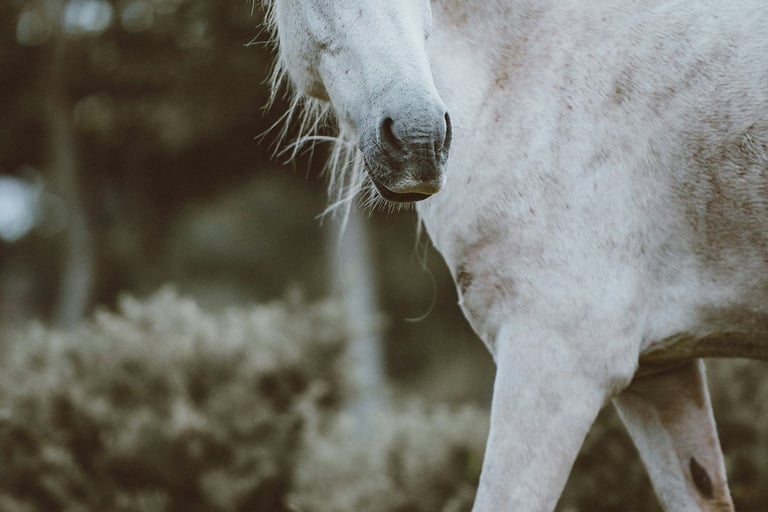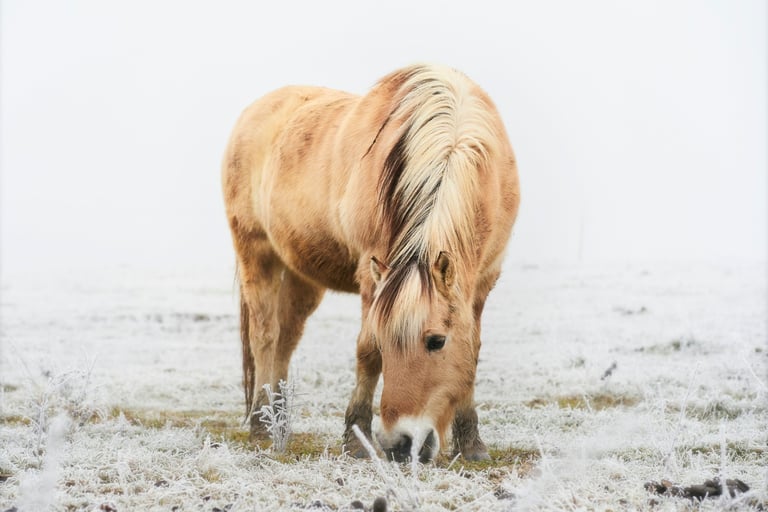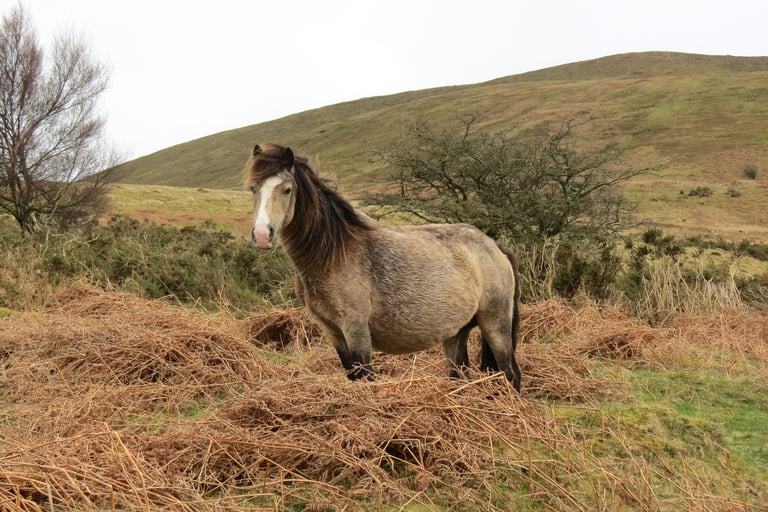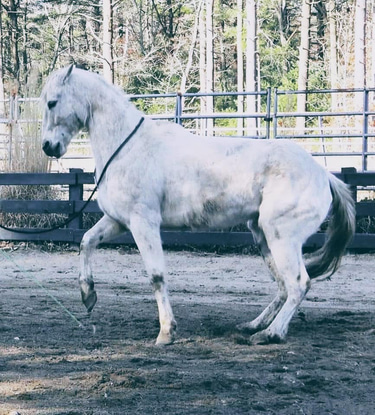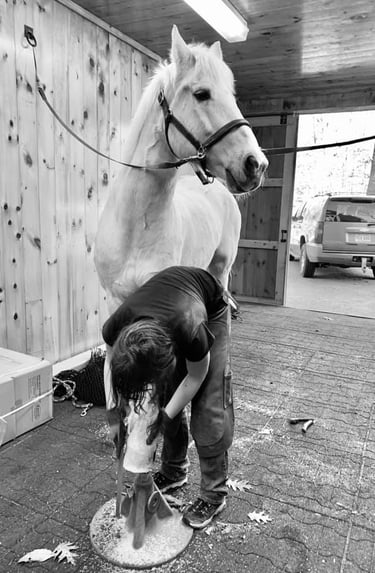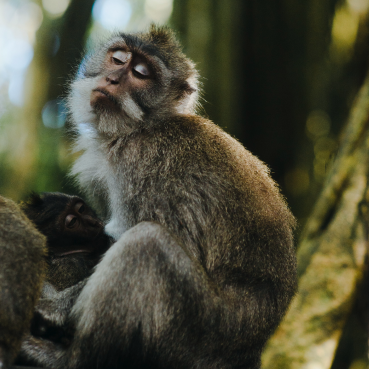understand insynergy - equineliberty (clickme)
♡ equine MAT training ♡
Existing client? view your timeline New client? Book now!
Manual alignment fusion of craniosacral therapy, myofascial releases, fascia training, healing movement and energy flowworks to release restrictions in the fascia and membranes that envelop the brain and spinal cord, helping to improve the flow of cerebrospinal fluid (CSF). By alleviating tension in the cranial sutures and vertebral joints, can restore better circulation of CSF, which supports nerve function and promotes optimal communication between the brain and spinal cord.
As the CSF flow normalizes, the pressure dynamics in the spinal cord and brain can improve, allowing for better waste removal, enhanced nutrient exchange, and a healthier environment for nerve tissue. With the removal of blockages in nerve pathways, CST can restore the normal transmission of sensory signals, improving the horse's ability to perceive limb position and coordinate movement more effectively.
Chronic pain from poor proprioception or nerve entrapments can manifest in behavioral changes or emotional stress. By enhancing CSF flow, nerve mobility, and musculoskeletal alignment, manual alignments promote recovery from both physical discomfort and emotional trauma, allowing the horse to regain more fluid flow and natural movement patterns - restoring nerve function and alleviating chronic muscle tension.
Craniosacral Therapy (CST) supports neurogenic issues and nerve impingement by addressing soft tissue, fascial restrictions, and alignment problems that affect nerve function. Nerves often become irritated or compressed due to tight fascia, misaligned cranial or sacral structures, or impaired cerebrospinal fluid (CSF) flow.

CST uses gentle, hands-on techniques to release these restrictions, reducing pressure on nerves and restoring their normal function. By improving cranial and sacral alignment, CST relieves tension in the dura mater (a protective membrane surrounding the brain and spinal cord) and enhances CSF flow, which nourishes nerves and reduces inflammation.
Additionally, CST shifts the body from a stress-driven sympathetic state (fight-or-flight) to a relaxed parasympathetic state (rest-and-digest), calming overactive nerves and promoting healing. In equines, CST can effectively address issues like trigeminal nerve hypersensitivity by releasing fascial tension around the jaw and cranial base, improving sensory and motor function.
Through these subtle yet powerful techniques, CST encourages the horse’s natural healing processes, relieving nerve irritation, enhancing movement, and improving comfort and behavior. It is a holistic and non-invasive approach to supporting equine health and well-being.

Introduction to MAT
In horses, as in other animals, the spinal cord is surrounded by CSF fluid which helps protect the spinal cord from mechanical injury and maintains an optimal environment for nerve function by transporting essential nutrients and oxygen to the spinal cord and brain, supporting their metabolic needs. CSF helps clear metabolic waste products (such as carbon dioxide and other by-products of cellular activity) from the spinal cord, maintaining the proper chemical balance for nerve cells to function optimally. CSF helps regulate the balance of ions, such as sodium and potassium, which is critical for nerve signal transmission.
what we need to know:
a busy mind storing tension in fascia folds in the body - dispersing impact of physical and emotional tension in harder to access with generalized movement areas like nerves and overlapping connective tissues (complex interactions between muscles, fascia, and nerves can limit movement and/or healing). CSF movement is partly driven by the pulsatile flow generated by the heart and the respiratory system. As the heart beats, it generates pressure waves that influence the flow of CSF through the brain and spinal cord. Likewise, breathing (especially deep breathing) creates pressure changes in the thoracic cavity that affect the CSF flow. Changes in posture, body position, or physical exertion can also affect CSF movement. Flexion or extension of the spine alters the pressure within the subarachnoid space, encouraging CSF to circulate differently. In situations where there is significant muscle tightness, such as during emotional stress or physical injury or chronic tension patterns the movement of CSF may become restricted, leading to potential issues with spinal cord and nerve function, manifesting either as pain or neurological dysfunction, or both :)
The CSF aids in clearing various neurotoxins, waste products of oxidative stress, and free radicals produced during normal metabolic processes or following injury and inflammation. If these waste products accumulate, they can damage the blood-brain barrier or the blood-CSF barrier, leading to a cascade of cellular dysfunction and inflammation that can contribute to chronic pain or nerve dysfunction. In horses, the proprioception system—which is essential for the body’s awareness of its own position in space—relies heavily on sensory input from various structures, including the musculoskeletal system and nervous system. The cranial nerves, specifically the trigeminal nerve (CN V), and other sensory components play a critical role in proprioception by transmitting information about the position of the limbs, head, and body to the brain- enabling coordinated movement and posture. Any dysfunction in this system, including disruptions to cranial nerve function, can impair the horse’s ability to perceive and control limb positioning, leading to altered movement patterns and potentially disruptive habits.
When proprioception is impaired, horses may rely more on visual cues or compensatory body movements, leading to overcompensated movement patterns. These could include habits like uneven weight-bearing, or overreaching with certain limbs, dragging limbs, or misaligned head postures which can result in long-term musculoskeletal stress and joint dysfunction.
why it's important?

In stressful situations, rapid breathing and elevated heart rate can increase the pressure in the thoracic cavity, which can, in turn, influence the movement of CSF within the subarachnoid space. The rhythm of CSF flow may become more pronounced, as the body attempts to clear metabolites and maintain a balanced biochemical environment under heightened physiological demands. At the level of the nerve endings, the distribution of CSF becomes particularly important. CSF surrounds the spinal cord and its nerve roots, ensuring that nerve endings in the peripheral tissues are adequately cushioned and supplied with the necessary nutrients. During periods of stress, the increased pulsatility of CSF flow, driven by elevated heart rate and respiration, may aid in ensuring that metabolic waste products are quickly removed from nerve tissues, which are working harder during stress.
it is updated with detailed overviews each time we make adjustments
what the stars mean on your pony-map:
red: significant tension or fascia knots that were worked on
orange: stressed areas likely due to compensatory patterns. usually accompanied by under- or over-developed muscles
yellow: secondary symptoms (nerve entrapments, disrupted energy flow)
pink: habitual stress or stored long-term tension patterns
green: improvements


Howdy! This Template is a pony-alized patient history portal
Even a slightly misaligned hyoid apparatus (the group of bones in the neck that support the tongue and larynx) in a horse can have a wide-ranging impact on the function and movement of fascia and certain muscles, even affect the nervous system. This anatomical misalignment can potentially lead to several neuromuscular and mechanical problems.
The brachial plexus is a network of nerves that originate from the cervical spine (C5–T1) and controls movement and sensation in the forelimbs. If the hyoid apparatus causes muscular imbalances or tension in the scalenus, brachiocephalicus, or trapezius, it may lead to compression or irritation of the brachial plexux. Even a small misalignment in this area can create a chain of issues that affects posture, muscle coordination, and nerve function.
The cervical nerve roots are responsible for motor control and sensation in the neck and upper limbs. Any misalignment or compression of these nerve roots due to a rotated hyoid can lead to numbness or tingling sensations along the neck, shoulders, or forelimbs.


The hyoid and cranial nerves are intricately connected with the jaw.


Every muscle in the horses body eventually connects to the hyoid.
The bones that make up the hyoid apparatus are the only bones in the body not to connect to another bone - they are held in place solely by ligaments.
what are fascia knots?


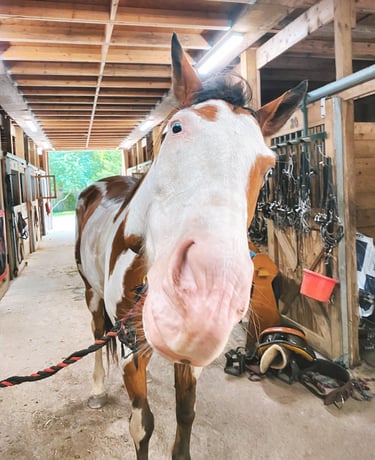

Also known as myofascial trigger points, are areas of tight, contracted muscle fibers and connective tissue within the fascia—the dense, web-like connective tissue that surrounds muscles, bones, and organs. Fascia serves as a supportive network, keeping structures in place while allowing for movement and flexibility. When the fascia becomes damaged, inflamed, or stressed, it can form adhesions or "knots." These knots feel like hard, tender lumps and often cause localized pain and discomfort. Fascia knots typically develop due to postural imbalances but can also form as a result of inactivity, overuse, injury, repetitive movements, psychological stress. The tissue can become stiff, reducing its ability to slide smoothly over muscles, causing a restriction in movement and limiting flexibility. These areas of tension can cause muscle stiffness, restricted range of motion, and pain, often leading to compensatory movement patterns.
Fascia knots may also interfere with nervous system communication, as they can irritate nerve endings and cause a sensation of pain or discomfort. This can lead to a further muscle response, creating a feedback loop that reinforces the knot and perpetuates the tension. Manual therapy techniques like myofascial release and craniosacral therapy are often used to release these knots and restore fluid movement within the fascia.
How Fascia Knots Tie Into Emotional Stress
Emotional stress can directly influence the formation of fascia knots, creating a deep connection between psychological states and physical tension. Under stress, the body activates the sympathetic nervous system (the fight-or-flight response), leading to increased muscle tone, tightening, and constriction in various parts of the body. Chronic emotional strain can cause some, usually deep, muscles to remain in a state of constant tension, restricting blood flow and oxygen, which creates the perfect conditions for fascia knots to form.
Additionally, emotional stress often leads to poor posture, which can place uneven strain on muscles and fascia. As the body compensates for misalignments, knots begin to form, especially around areas of tension. In horses, emotional stress—whether due to trauma, anxiety, or tension—can lead to the formation of these physical blocks, hindering both movement and emotional recovery. Addressing fascia knots can help release both physical and emotional tension creating a more balanced and relaxed state for the equine.

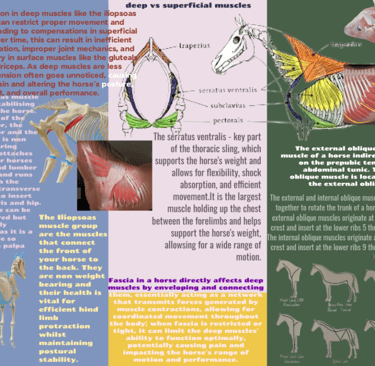
Fascia knots tend to form more around the deep muscles because these muscles are responsible for stabilizing the body and maintaining posture, and they are often subjected to greater, sustained tension. Deep muscles, such as those in the core, spine, and pelvis, provide essential support for postural alignment and balance. When these muscles are under strain, whether from poor posture, repetitive movement, or injury, the fascia surrounding them can become tight and restricted, leading to the formation of knots. Deep muscles are also more likely to be affected by stress or compensation, where ongoing tension in one area creates a ripple effect of tightness throughout the body.
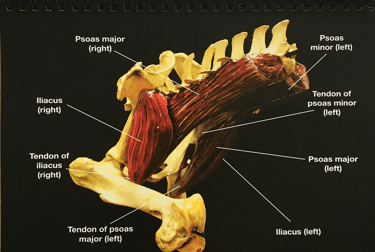

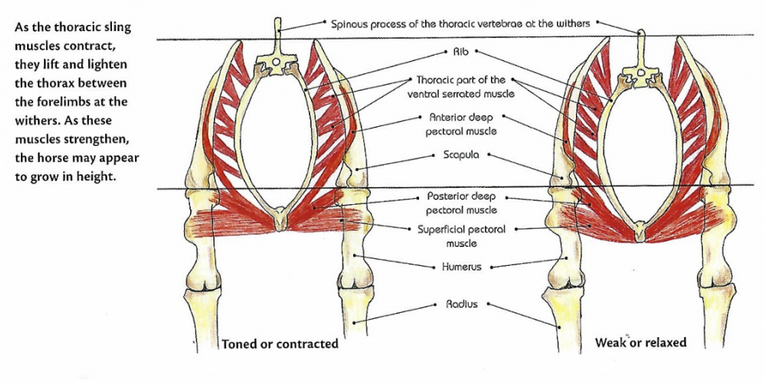

Manual alignment therapy, including craniosacral therapy and myofascial release, is highly effective in helping horses activate the parasympathetic nervous system (PNS), which is key to promoting deep healing. These therapies involve gentle, targeted touch to release fascial restrictions and realign the craniosacral system, enhancing cerebrospinal fluid flow and techniques that focus on restoring balance in the body by addressing restrictions in the fascia, muscles, and nervous system. Realigning cranial bones and connective tissue, the therapies create a calming effect that encourages the body to shift from the sympathetic (fight-or-flight) to the parasympathetic (rest-and-repair) state.
Cerebrospinal fluid (CSF) plays a crucial role in the removal of metabolic waste products from the spinal cord and brain. This function is vital for maintaining the proper chemical environment required for optimal nerve function and preventing the buildup of potentially harmful by-products that could interfere with normal neurological activity. The process of waste removal in the spinal cord primarily involves the exchange of metabolites and ions between the extracellular space of the brain and spinal cord and the CSF. Chronic tension, especially in response to stress or emotional trauma, can significantly affect the flow and circulation of CSF. When the body is under continuous stress, it often leads to prolonged muscle tension, spinal misalignment, and neural entrapments, all of which can restrict the optimal flow of CSF and, in turn, interfere with its waste removal processes.
Prolonged activation of the sympathetic nervous system can lead to vasoconstriction in the blood vessels, reducing blood flow to the brain and spinal cord. This can reduce the ability of the vascular system to exchange waste products and nutrients with the CSF, causing poor waste clearance and an accumulation of metabolic by-products within the central nervous system.
Deep muscle tension in equines often causes altered movement patterns, leading to overcompensation by related superficial muscles. When deeper muscles, such as those in the core or back, become tight or restricted, the surface muscles may take on extra work to stabilize or propel the body. Over time, this compensatory overuse can lead to muscle fatigue, strain, and eventual atrophy of the deep muscles. The superficial muscles, in turn, may become hypertrophied or overdeveloped due to overuse, while the deeper muscles weaken, creating an imbalance that can worsen the tension and stress on the entire musculoskeletal system. This cycle affects both muscle function and overall posture, increasing the risk of injury.
cool. Muscles. And below ALL THAT ?
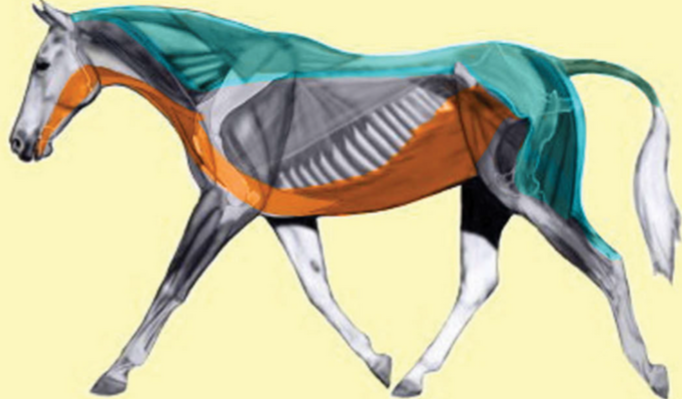

Every muscle in the horses body eventually connects to the hyoid.
The bones that make up the hyoid apparatus are the only bones in the body not to connect to another bone - they are held in place solely by ligaments.
The deep muscles of the neck that help attach the neck to the thoracic cavity (the chest region) are primarily responsible for stabilizing the cervical vertebrae, supporting the connection between the neck and the thoracic spine, and enabling the movement of the neck relative to the chest and shoulders. These muscles help in anchoring the neck to the thoracic region and assist in various neck functions like flexion, extension, and lateral movement.
Cranial Nerve XI (Accessory Nerve): innervates the trapezius, sternocleidomastoid, and other muscles in the neck and shoulders. Compression or irritation of the accessory nerve due to a rotated hyoid apparatus can reflect on surrounding deep muscles.
Cranial Nerve V (Trigeminal Nerve): Although the trigeminal nerve mainly serves the face, it can also be involved in referred pain if tension or misalignment in the hyoid apparatus causes discomfort or changes in the neck's posture. This may manifest as sensitivity around the face, jaw, or sinuses.
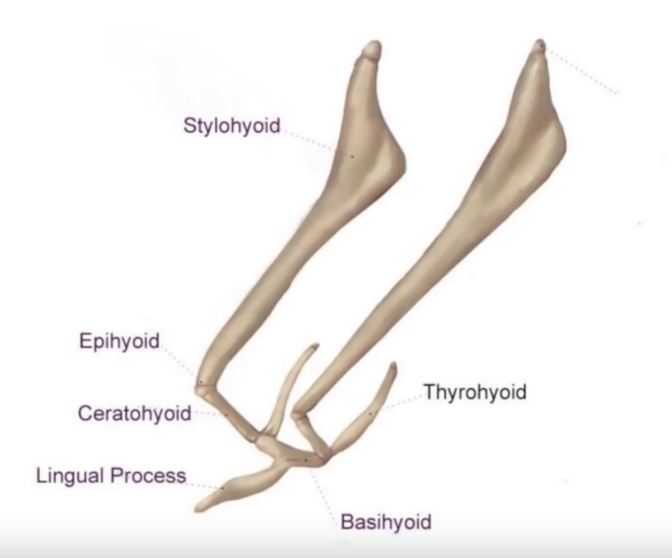

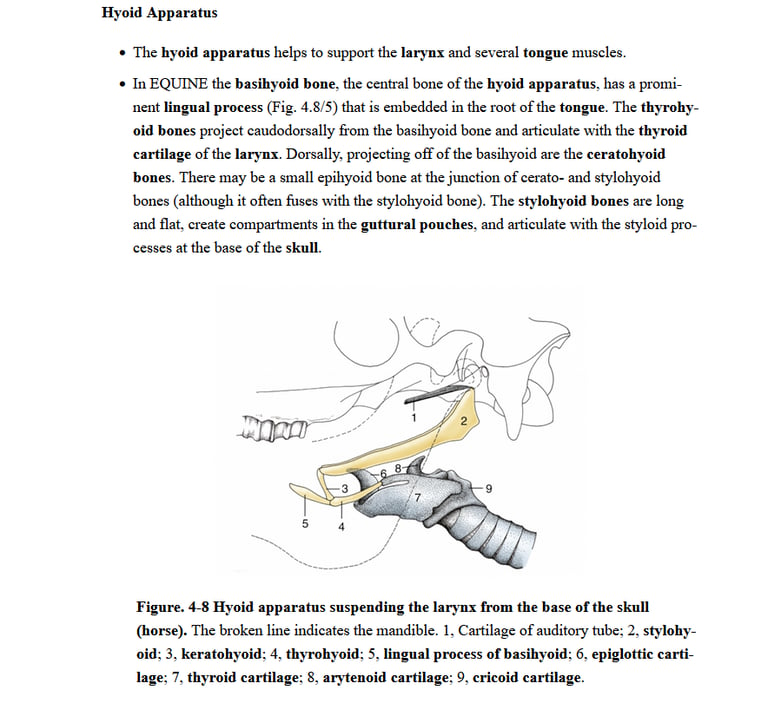

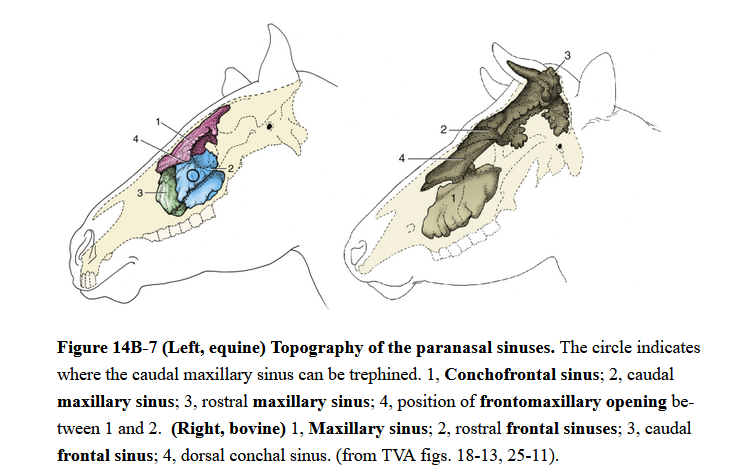

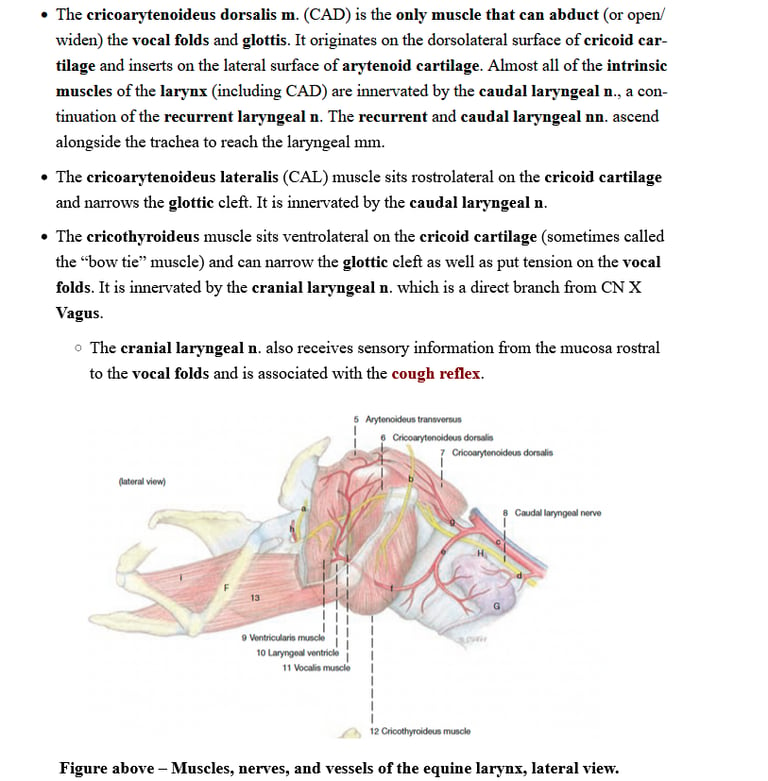

The hyoid apparatus consists of a selection of small bones that articulate together. Its name means "shaped like the letter upsilon (Y)", and it is situated at the base of the skull; between the cheeks of the horse. The hyoid apparatus connects to the skull via the temporohyoid joint. At this joint, the hyoid apparatus articulates with the skull. The hyoid apparatus gives biomechanical form and function to the larynx, pharynx and the tongue.


The position of a fetus during gestation can influence the development of certain cranial nerves and associated structures. If a horse fetus is positioned in a way that causes compression or restriction of the facial nerve or the cranial nerve roots during the critical period of nerve development, it could lead to improper development or positioning that may or may not interfere with other factors later in life yet with properly timed care addressing arising symptoms helping the body into functional alignment the horse may learn to manage and use his features with little to simple routine maintenance therapies like accupuncture, craniosacral and similar. Injury, trauma or habits isn't always the cause of misalignments, fascia knots or stress tension.
The tongue connects to the hyoid apparatus.
The hyoid apparatus has muscular connections from the throat to the forelimbs (omothyroid), shoulder (omohyoid) and sternum (sternohyoid).
Sternohyoid = hyoid to sternum; Omohyoid = basihyoid to medial scapula/subscapular fascia; these muscles provide a direct connection from the hyoid apparatus to the shoulder of the horse via the ventral neck. Tension within these muscles, along with sternothyroid, results in restricted shoulder movement and the development of hypertonicity. Contraction of these muscles can put strain on the temporomandibular joint (TMJ). Additionally, hypertrophy and hypertonicity of the sternocephalic muscle can occur when the horse strains against the bit as a result of negative pressure upsetting the hyoid apparatus.
The muscle chain continues ventrally, connecting the pectoral area to the abdominal muscles.
The abdominal muscles are connected to the pelvic muscles.
Small muscles of the hyoid apparatus connect to the TMJ and the poll. The TMJ has a dual purpose of mastication and registering of postural information. Therefore, it is an important anatomical location for nerves that control proprioception and balance; the highest concentration of mechanoreceptors (sensory nerves that report shape change) are found in the periphery of the disc and at the attachment site of local ligaments.The TMJ articulates with the hyoid apparatus.
Hypertonicity of the hyoid musculature = often have lateral imbalances of the hyoid bones. When viewing the horses head from underneath, the tongue can be located in the depression between the two ramus of the mandibles. Applying gentle pressure underneath can identify a bony structure, which is the basihyoid bone. Lumps around this area are likely saliva glands. Feeling the location of this bone can determine deviation of the hyoid. Sliding the tips of the fingers along the inside curvature of the mandible upwards can move the hyoid gently to determine tension.

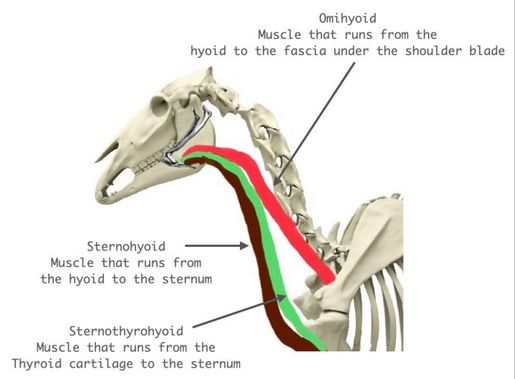

A slightly rotated hyoid apparatus (the group of bones in the neck that support the tongue and larynx) in a horse can have a wide-ranging impact on the function and movement of fascia and certain muscles, even affect the nervous system. This anatomical misalignment can potentially lead to several neuromuscular and mechanical problems.
The brachial plexus is a network of nerves that originate from the cervical spine (C5–T1) and controls movement and sensation in the forelimbs. If the hyoid apparatus causes muscular imbalances or tension in the scalenus, brachiocephalicus, or trapezius, it may lead to compression or irritation of the brachial plexux. Even a small misalignment in this area can create a chain of issues that affects posture, muscle coordination, and nerve function.
The cervical nerve roots are responsible for motor control and sensation in the neck and upper limbs. Any misalignment or compression of these nerve roots due to a rotated hyoid can lead to numbness or tingling sensations along the neck, shoulders, or forelimbs.
Every muscle in the horses body eventually connects to the hyoid.
The bones that make up the hyoid apparatus are the only bones in the body not to connect to another bone - they are held in place solely by ligaments.


The hyoid and cranial nerves are intricately connected with the jaw.

Frequently Asked Questions:
CSF surrounds the brain and spinal cord, helping protect them from mechanical injury. It also facilitates the removal of waste products like carbon dioxide and cellular by-products, maintaining an optimal chemical environment for nerve function and supporting healthy neurological activity
Fascia knots create localized muscle tightness that can restrict range of motion and cause postural imbalances. Horses may develop abnormal movement patterns, such as favoring one limb or stiffness in the neck, which can lead to gait abnormalities and compensatory behaviors. This affects overall movement and coordination.
how do fascia knots affect a horse's movement and posture?
What is the role of cerebrospinal fluid (CSF) in a horse’s nervous system?
how does stress impact csf flow in a horse?
Chronic stress can lead to muscle tension, spinal misalignment, and nerve entrapments, which all restrict the optimal flow of CSF and overtime cause the horse's body to tighten and re-adjust fascia distribution to accommodate the changes for pain avoidance. Horses under chronic stress or after experiencing emotional trauma often develop chronic tension that results in postural imbalances and movement dysfunction.
can fascia knots be linked to emotional stress in horses?
Emotional stress can contribute largely to muscle tension, which creates an environment conductive to the formation of fascia knots with or without physical stress present.
Fascia knots and nerve entrapments can compress nerve pathways, causing localized pain, inflammation and even referred discomfort in surrounding or related areas. As the nervous system becomes compromised, it can lead to ongoing muscle tightness, compensatory movement patterns, and gait abnormalities, resulting in long-term discomfort or chronic pain.
how do fascia knots and nerve entrapments lead to chronic pain or discomfort in horses?
Craniosacral therapy uses gentle, non-invasive hands-on techniques to release restrictions in the fascia and craniosacral system. The therapy improves CSF flow, reduces muscle tension and restores alignment in the spine and nervous system, allowing the body to heal more effectively and relieve pain assosciated with fascia knots and nerve entrapments.
how exactly does craniosacral therapy help horses with fascia knots in horses?
Myofascial release targets the fascia surrounding muscles, breaking down adhesions and relieving muscle tightness. This technique helps restore flexibility and range of motion, reduces pain and inflammation and can improve overall movement efficiency, particularly in areas where fascia knots cause restrictions.
what are the benefits of myofascial release in treating fascia restrictions in horses?
can fascia knots affect horses of all ages?
Fascia knots can affect horses at any age. Young horses may develop knots due to growth related issues or improper training techniques, limited movement and many other environmental factors, while older horses may experience tension from chronic use or degenerative changes. Horses of all ages can also develop fascia knots and restrictions as a result of emotional stress, trauma or poor posture.
how does chronic tension in horses lead to neurological dysfunction?
How can addressing fascia knots and nerve entrapments help prevent hoof abscesses?
















Facsia knots and restricted blood flow can cause stagnant toxins to accumulate in the body, including the lower limbs and eventually hooves (bloodflow, gravity). Inadequate circulation and waste removal can lead to inflammation and the formation of abscesses. By releasing fascia knots and improving circulation through healing nutrition, waste products are more effectively cleared.
Chronic tension from muscle stiffness, fascia knots, and structural misalignments can compress nerve pathways, leading to nerve dysfunction. This can impair proprioception (limb position sense), cause muscle weakness, and disrupt normal movement patterns. It can also affect the autonomic nervous system, leading to increased stress and difficulty recovering from injury/exertion or adjusting to small everyday changes.


